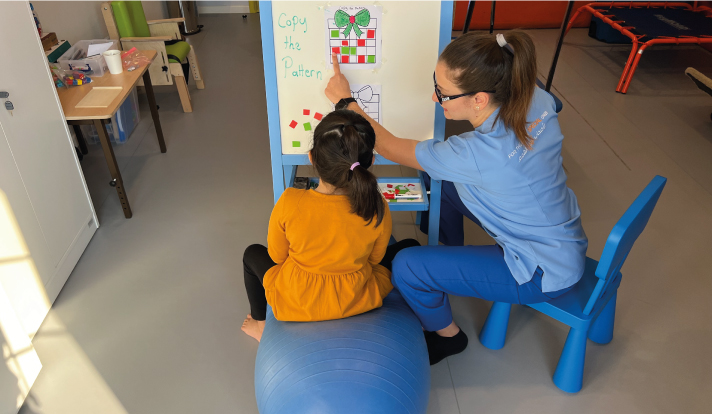You know how the holiday season is a magical time filled with love, laughter, and precious family traditions? Well, let’s keep it real as it can also be a bit challenging with all the busyness, lack of schedule, and occasional chaos thrown in.
I’ve noticed that some parents, especially those with kids with sensory processing difficulties, often find themselves facing unique challenges during busy seasons. Hence, the holidays can bring a unique set of stressors instead of being relaxing.
As an occupational therapist, I understand the importance of providing support and practical strategies to make the season more enjoyable for everyone, considering the needs of the child and the entire family. In this blog, we’ll explore sensory strategies during winter break, offering practical tips for a more relaxing and less stressful holiday.
Create a Sensory-Friendly Environment: during the holiday season, homes are often filled with decorations, lights, and various textures. While these elements contribute to the festive atmosphere, they can be overwhelming for children with sensory processing difficulties.
Create a special quiet space where your child can retreat when the sensory input becomes too much. This space should be equipped with calming activities, soft lighting, weighted blankets, and comfortable seating to offer a time-out during moments of sensory overload.
- A therapist tip: for those quite spaces prepare a Quiet-Time Box. Fill it up with easy “do it yourself” toys and games – think puzzles, books, iPad, drawing, listening to music, or watching a movie. The key is to pick items that don’t require constant supervision, so both the kiddo and you can feel confident in having some independent fun. It’s a game-changer for those moments when you all need a breather!
Prepare for Social Times! Social functions can be challenging for some children due to unfamiliar faces and overstimulating environments. Prepare with:
- Photos: review family photos before family gathering as this will help your child feel more at ease, providing them with a sense of familiarity about who will be present and the faces they expect to see.
- Prepare an on-the-go bag: for various occasions such as long trips, visits to relatives’ homes, outings to festival parks, or even international travels. Fill the bag with familiar comforts from home to bring along to social events. What goes into the bag depends entirely on your child’s needs. Consider including items like noise-cancelling earplugs, chewy snacks, fidget toys, weighted lap pads, sunglasses, and sensory-friendly clothing, perhaps layered for warmth or cooling, depending on the climate
- Food considerations: consider the impact of food on your child’s mood and attention. Ensure that they have healthy snacks, and also have a chat with family/relatives about offering foods outside their usual diet, especially sweets. Pack familiar snacks for comfort during trips, provide explanations when introducing new foods and offer alternatives if specific foods pose discomfort. Keep those little tummies happy and healthy!
- Choose Sensory-Friendly Venues: when planning outings, think about your child’s sensory needs. Give places a call beforehand to check if they have quiet spots or sensory-friendly options. Consider things like lighting, crowd levels, and activities offered. Prep your kid for where you’re headed and be flexible for any adjustments needed. Share pictures or social stories and discuss the various sensory experiences they may encounter. It makes a big difference!
- Keep an eye out for when your kid might need a breather at those gatherings. Set up a signal or word so they can directly let you know when they need a sensory break. Use this time to step back, do some calming activities, or just chill out in a quiet spot.
Prepare for Changes in Routine BUT also Keep Bits of Your Routine! As the holiday season is a break from school and work, it disrupts familiar routines. To maintain a sense of structure and reduce chaos:
- Use visual schedules and calendars to provide a clear timeline of holiday activities. Prepare your child by gradually introducing changes and discussing upcoming events.
- Gather key family members (kids included if it fits) and brainstorm ideas. Discover what each family member enjoys and wants to do.
- Aim for one daily activity, keeping it simple and local. It could be car-ride, a visit to the park, or just some garden play. Don’t overdo it, simple plans work best. Tailor it to everyone, including yourself.
- Think about creating a schedule that maintains some familiar daily routines but add a couple of simple surprise activities (such as baking cookies or making holiday decorations). Place the schedule in a visible spot. For example, you can keep the same wake-up and bedtime routines but add 1-2 new activities in between, some independent time, dinner then a bath, or story time. This way, even with different activities, you’ll have a structure to follow.
Create a “Let’s Move” Corner: for your active kiddos, set up a space with pillows, stuffed animals, and favourite games then design a fun obstacle course or dance to lively music to let them burn off energy. Get them involved in household chores! Have them set the table, tidy up, make their beds, fold dry clothes, and put them away. Include outdoor play, trampoline jumping, swinging, water play, swimming (if the weather allows), or biking. Before long trips, engage in physical activities.
- A therapist tip: If beach time is on the agenda, prep ahead. Discuss the beach environment, apply sunscreen with tactile sensitivities in mind, and introduce your child to the feel of sand at home. Consider accessories like goggles or earplugs.
- Another tip: Make sure your child knows fun ends. Help your child manage time. Use a timer, give them a watch or clock, and provide warnings. Smooth transitions between activities are essential.
Mindful Gift Giving: when selecting gifts, choose items that align with their sensory needs and preferences, whether it’s a cozy blanket, fidget tools, or sensory-friendly toys. Be mindful of the potential sensory impact of wrapping paper and packaging and consider alternatives if necessary.
Avoid Sensory Overload:
- Skip crowded malls.
- Keep activities short and focused.
- Break longer tasks into smaller segments with sensory breaks such as deep pressure activities like hugs, weighted blankets or dimming lights and reducing distractions for calming down.
- Include movement breaks like jumping jacks or yoga.
- Follow their lead. Observe your child’s behaviour and adjust activities accordingly.
- If you’re traveling, review airport facilities to assess how they can assist children with sensory needs.
Self-Care Reminder: plan ahead, BUT don’t over plan; ask for help when needed prioritize your well-being. Use your calendar to manage time and stress. Accept that you can’t do it all and take regular breaks.
Let’s craft a holiday plan that’s both festive and stress-free. Thoughtful planning transforms winter break into a time of joy and relaxation for children and their families. Embrace your child’s uniqueness, learn from every moment, and jot down notes for the future. Remember that it’s time to relax, not panic. Embrace the special moments and know that you’ve got this! Here’s to a joyful and peaceful holiday season for you and your loved ones. Merry Christmas and Happy New Year!





